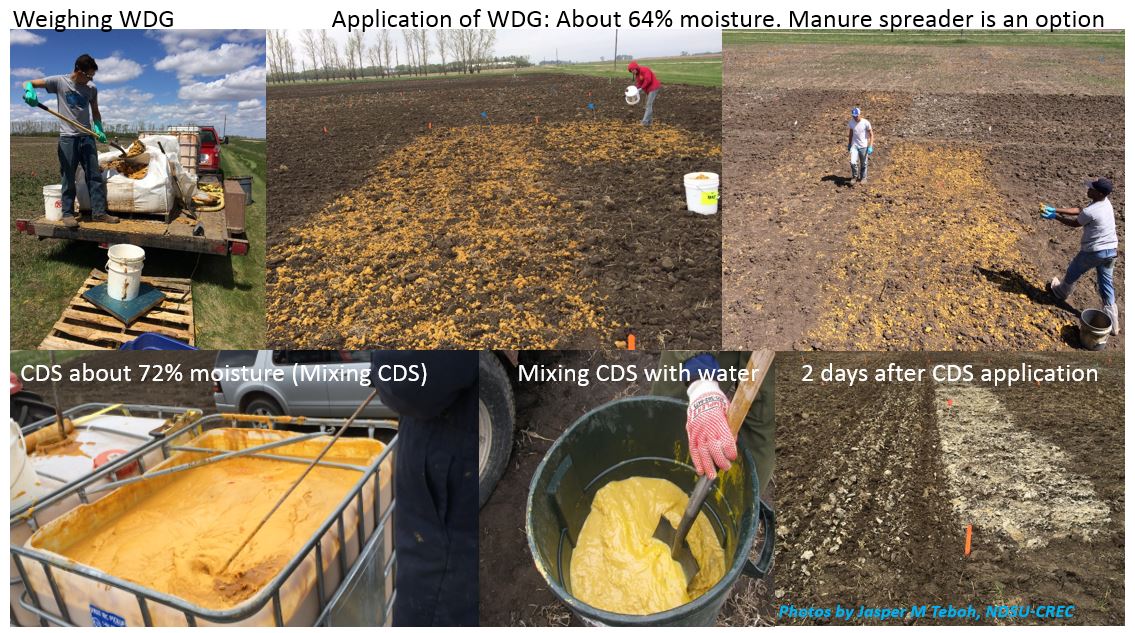Proceedings Home | W2W Home 
Purpose
Some farmers in North Dakota are showing growing interest in applying coproducts from ethanol production, as sources of nutrients for crop production, especially corn and wheat. The majority of these coproducts are used as livestock feedstuff, but sometimes, due to a combination of factors, ethanol plants have a surplus of condensed distillers solubles (CDS) and wet distillers grain (WDG). Under those circumstances, the price of CDS and WDG can drop significantly, and due to their nutrient content, it might make financial sense to use them as a source of nutrients for crop production instead of commercial fertilizers. Cognizant of current low market prices of wheat and corn, farmers are seeking effective and less expensive sources of nutrients for their crops. Farmers also like the concept of recycling the nutrients exported in the corn kernels back into the soil in the form of CDS and WDG.
What Did We Do?
We conducted studies in Carrington (2015 and 2016) and Fairmount (2015), ND. We assessed the impact of CDS and WDG compared to triple super phosphate (TSP) fertilizer as sources of phosphorus (P), on grain yield and quality of corn (2015 and 2016) at rates of 0, 40, 80, 120 lbs P2O5/ac, and wheat (2016) at rates of 0, 40, 80 lbs P2O5/ac. Treatments were surface applied and incorporated. CDS was mixed with water to facilitate application. The check (0 lbs P) and TSP treatments received recommended N as urea.

What Have We Learned?
In 2015, corn yields from CDS treatments were consistently greater than yields from WDG and TSP at each P level at Carrington. Corn did not respond to P application at Fairmount. In 2016, corn yields were significantly greater for WDG treatments than for CDS and TSP, which produced similar yields. Wheat yields and protein were also significantly higher for WDG compared to TSP. Therefore, CDS and WDG can be valuable sources of P and other nutrients for grain crops in North Dakota.
Future Plans
We will continue assessing the P fertilizer value of CDS and WDG for corn and wheat in 2017. A separate study will assess in-furrow treatments with CDS. Finally, we will assess soil residual effects from CDS and WDG application to soil on subsequent crops, as well as potential economic implications for farmers.
Authors
Jasper M Teboh, Research Soil Scientist, NDSU – Carrington Research Extension Center
Other Authors
Joel Ransom, Extension Agronomist – Cereal Crops, NDSU – Department of Plant Sciences
Szilvia Yuja, Research Soil Specialist, NDSU – Carrington Research Extension Center
J. Paulo Flores, Precision Ag Specialist, NDSU – Carrington Research Extension Center
Additional Information
Please contact me with questions at Jasper.Teboh@ndsu.edu or by phone at 701-652-2951 (Ext 109).
Results from this research were first presented at the ASA/SSSA/CSSA 2016 annual conference in Phoenix and is accessible at:
https://scisoc.confex.com/crops/2016am/webprogram/Paper100533.html
A summary of findings was later presented on the NDSU – Carrington REC blog at
Acknowledgements
The authors are grateful to the North Dakota Corn Council, and North Dakota Agricultural Products Utilization Commission for funding the corn and wheat projects, respectively. Our gratitude also to Tharaldson Ethanol (Casselton, ND) especially Mr. Keith Finney and Mr. Brad Kjar; Mr. Greg LaPlante, Mr. Chad Deplazes (Research Specialist at NDSU), CREC technicians, staff, and students for field support.
The authors are solely responsible for the content of these proceedings. The technical information does not necessarily reflect the official position of the sponsoring agencies or institutions represented by planning committee members, and inclusion and distribution herein does not constitute an endorsement of views expressed by the same. Printed materials included herein are not refereed publications. Citations should appear as follows. EXAMPLE: Authors. 2017. Title of presentation. Waste to Worth: Spreading Science and Solutions. Cary, NC. April 18-21, 2017. URL of this page. Accessed on: today’s date.

